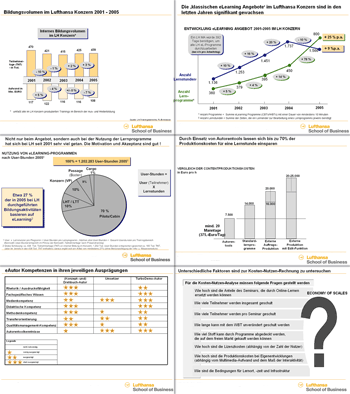 Durch eine nicht mehr zurückverfolgbare Kette von Links bin ich auf einen noch recht frischen Beitrag (vom Dezember 2006) von Udo Sonne (Senior Manager eLearning Competence Center, Lufthansa AG, Frankfurt am Main) gestoßen. Sonne stellte im Rahmen des Palomita-Kolloqiums der Fachhochschule für Technik und Wirtschaft in Berlin die Entwicklungen, Erfahrungen und Strategien zum Thema „Rapid eLearning“ vor. Der Titel ist ein wenig irreführend, denn – und das ist mir auch erst nach dem anschauen des Vortrags klar geworden – wenn Sonne von „Rapid eLearning“ spricht, meint er im wesentlichen auch „Rapid eLearning Content Production“ und genau da hat LH einige interessante Entscheidungen gefällt.
Durch eine nicht mehr zurückverfolgbare Kette von Links bin ich auf einen noch recht frischen Beitrag (vom Dezember 2006) von Udo Sonne (Senior Manager eLearning Competence Center, Lufthansa AG, Frankfurt am Main) gestoßen. Sonne stellte im Rahmen des Palomita-Kolloqiums der Fachhochschule für Technik und Wirtschaft in Berlin die Entwicklungen, Erfahrungen und Strategien zum Thema „Rapid eLearning“ vor. Der Titel ist ein wenig irreführend, denn – und das ist mir auch erst nach dem anschauen des Vortrags klar geworden – wenn Sonne von „Rapid eLearning“ spricht, meint er im wesentlichen auch „Rapid eLearning Content Production“ und genau da hat LH einige interessante Entscheidungen gefällt.
Auf den eVideo-Seiten des Projekts ist der komplette Vortrag von Herrn Sonne als Breeze-Desktop-Aufzeichnung (Folien mit Audio) abrufbar (Details hier). Der gesamte Vortrag ist als PDF downloadbar. Auch als Podcast ist der Beitrag abrufbar.

Auszug aus Folien: Bild anklicken für große Darstellung
Bei 493.000 Teilnehmertagen pro Jahr an Bildungsmaßnahmen bei der Lufthansa sind mittlerweile 27% eLearning-basiert! Dieser Vortrag ist vor dem Hintergrund meines Beitrags zu den „Virtuelle Hochschulen in Deutschland: Wer ist erfolgreich?“ eine spannende Sache. Denn, hier kann man einen direkten Vergleich anstellen zwischen Wirtschaft und Staat. Bemerkenswert finde ich die Transparenz von Lufthansa, die durch die gelieferten Informationen beispielhaft erscheint im Vergleich zu (virtuellen) Hochschulen in Deutschland. Hier bekommt man Zahlen und Fakten, die zugleich ein Aushängeschild sind und damit zugleich ein erfolgreiches Marketing darstellen.
Von vielen (virtuellen) Hochschulen in Deutschland ist solcherlei Information selten zu erhalten, geschweige denn, das soetwas offen für die Öffentlichkeit einsehbar wäre. Lufthansa stellt die eigene Entwicklung dar und zeigt auch, das nicht alles reibungslos läuft bei dem Einsatz von neuen Technologien. Wer aber keine Fehler bei einem solchen Umbruch macht, der hat vermutlich auch nicht sonderlich probiert die Grenzen auszuloten. Andererseits zeigt Lufthansa damit, wie der Entschluss zum Wandel und zu steter Verbesserung umgesetzt und durch eigens entwickelte Instrumente begleitet werden kann. Aus meiner Sicht ein kleines Lehrstück in Sachen Innovation, Leadership und Kommunikation!
Why do I blog this? Gerade im staatlichen Bereich ist erschreckend oft zu beobachten, wie wenig Transparenz bei den Entwicklungen vorherrscht. So werden Evaluationsergebnisse von Gutachtern und/oder Kommissionen selten offengelegt oder herausgegeben. Entwicklungsstrategien werden selten veröffentlicht geschweige denn dem öffentlichen Diskurs ausgesetzt. Einzig wenn eine existenzbedrohliche, finanzielle Entscheidung durch die Politik auf der Tagesordnung steht, tauchen die staatlichen Projekte in der Öffentlichkeit durch Schlagzeilen auf; Meistens negativ konnotiert! Woran liegt das? Warum nutzen staatliche Projekte in z.B. (virtuelle) Hochschulen nicht die Chance, Ihre Arbeit und Entwicklung kontinuierlich öffentlich vorzustellen. Warum werden kaum Zahlen und Ergebnisse zum Erfolg oder auch Misserfolg veröffentlicht? Aus den Fehlern könnten andere ja schliesslich auch lernen! Kurz: Warum läßt sich der Staat und seine Projekte diese großartige Chance zum Marketing in eigener Sache entgehen, die internationale und nationale Wirtschaftsunternehmen wie Lufthansa so trefflich ergreifen? Ich fasse mir dabei durchaus auch an die eigene Nase!!! All dies hat mich bewogen diesen Vortrag hier zu erwähnen. Eine Zusammenfassung (quasi das Executive Summery) der Ergebnisse der Bemühungen bei Lufthansa ist in meinen Augen dieses PDF-Dokument. Ich finde den vorgestellten Beitrag der Lufthansa führend, man kann daraus viel lernen und er gibt zugleich einen Überblick zum aktuellen Technologiestand bei LH! Ganz einfach „Frontier of Science, Technology & Learning“.

 There’s some sexappeal in the concept of the „Wisdom of the Crowd“. It promises you only need to have enough people building a crowd to get a wise solution! But what kind of problems are fitting to this concept of problemsolving? Kathy Sierra has now thought about this in detail and put up a really thought provoking blogpost entitled
There’s some sexappeal in the concept of the „Wisdom of the Crowd“. It promises you only need to have enough people building a crowd to get a wise solution! But what kind of problems are fitting to this concept of problemsolving? Kathy Sierra has now thought about this in detail and put up a really thought provoking blogpost entitled  I think wisdom will appear, as soon as the unique efforts of every individual are summed up to complement something. So the wisdom is lying in the very individual effort. Dumbness will establish as soon as the unique effort will become meaningless by amplification or consenus. So, from my perspective it is amplification of the already known versus complementing the already known with a different approach in hope for „the best unique effort takes it all“-consensus.
I think wisdom will appear, as soon as the unique efforts of every individual are summed up to complement something. So the wisdom is lying in the very individual effort. Dumbness will establish as soon as the unique effort will become meaningless by amplification or consenus. So, from my perspective it is amplification of the already known versus complementing the already known with a different approach in hope for „the best unique effort takes it all“-consensus. If there is a family in a car leaving their home for a holliday trip, there is ONE person doing the steering of the car. The clasic wisdom of the crowds concept suggests that you should have FOUR drivers. but this would mean e.g. steering the car to the left to introduce some overtaking-maneuver and at the same time slowing the car down (because perhaps one person descides to cancel its opinion about overtaking). Driving a car using wisdom of the crowd seems to result in 100% chaos.
If there is a family in a car leaving their home for a holliday trip, there is ONE person doing the steering of the car. The clasic wisdom of the crowds concept suggests that you should have FOUR drivers. but this would mean e.g. steering the car to the left to introduce some overtaking-maneuver and at the same time slowing the car down (because perhaps one person descides to cancel its opinion about overtaking). Driving a car using wisdom of the crowd seems to result in 100% chaos. The naive „Wisdom of Crowds“ approach results in NO ONE taking responsibility for action. That’s why it will fail! It seems to be a different situation, if we have a crowd in search for direction, so an indifferent crowd for example. In a case where no efforts are made the slightest effort will be in the position of „the best unique effort takes it all“-consensus immediately. This is what we admire in social groups of animals (like ants) which operate in swarm structures. There the group/swarm steers itself as soon as some kind of „the best unique effort takes it all“-consensus is reached. Perhaps the basic effect which drives the socalled „Wisdom of Crowds“ is more some kind of „
The naive „Wisdom of Crowds“ approach results in NO ONE taking responsibility for action. That’s why it will fail! It seems to be a different situation, if we have a crowd in search for direction, so an indifferent crowd for example. In a case where no efforts are made the slightest effort will be in the position of „the best unique effort takes it all“-consensus immediately. This is what we admire in social groups of animals (like ants) which operate in swarm structures. There the group/swarm steers itself as soon as some kind of „the best unique effort takes it all“-consensus is reached. Perhaps the basic effect which drives the socalled „Wisdom of Crowds“ is more some kind of „